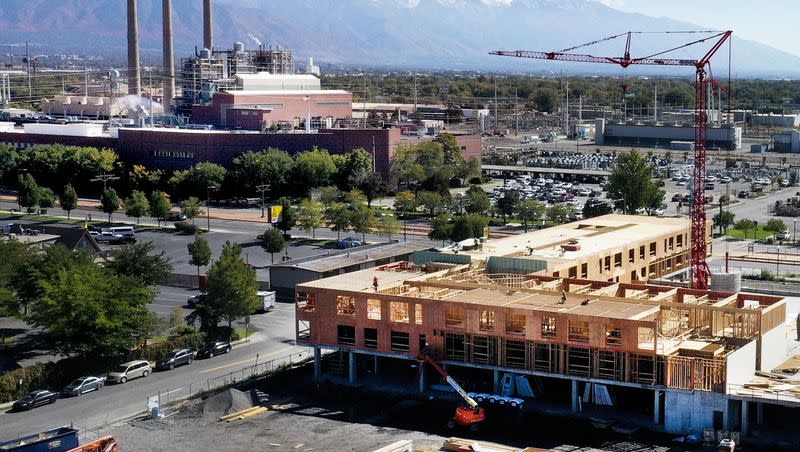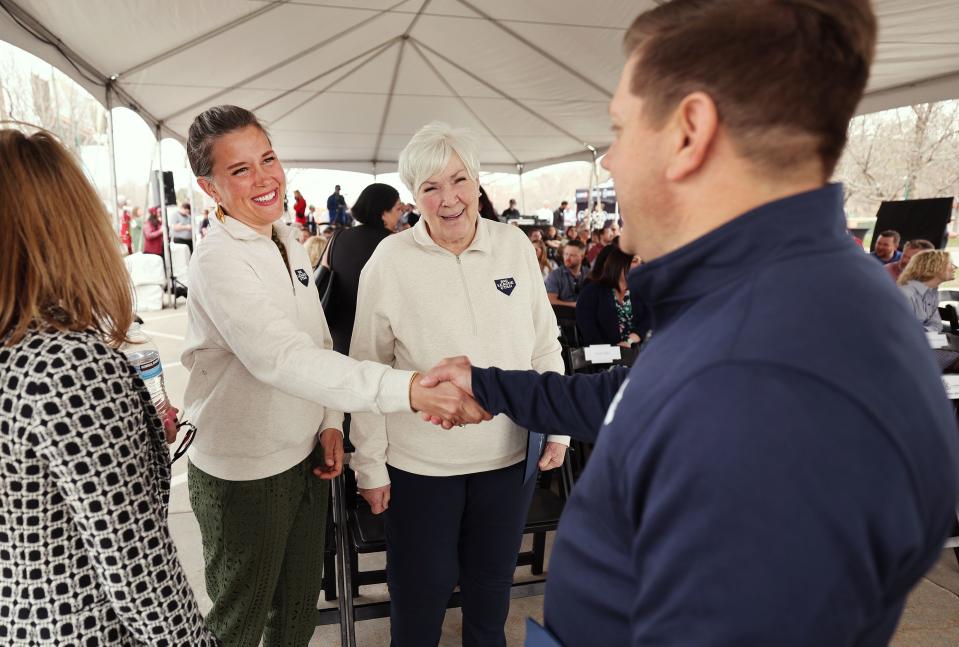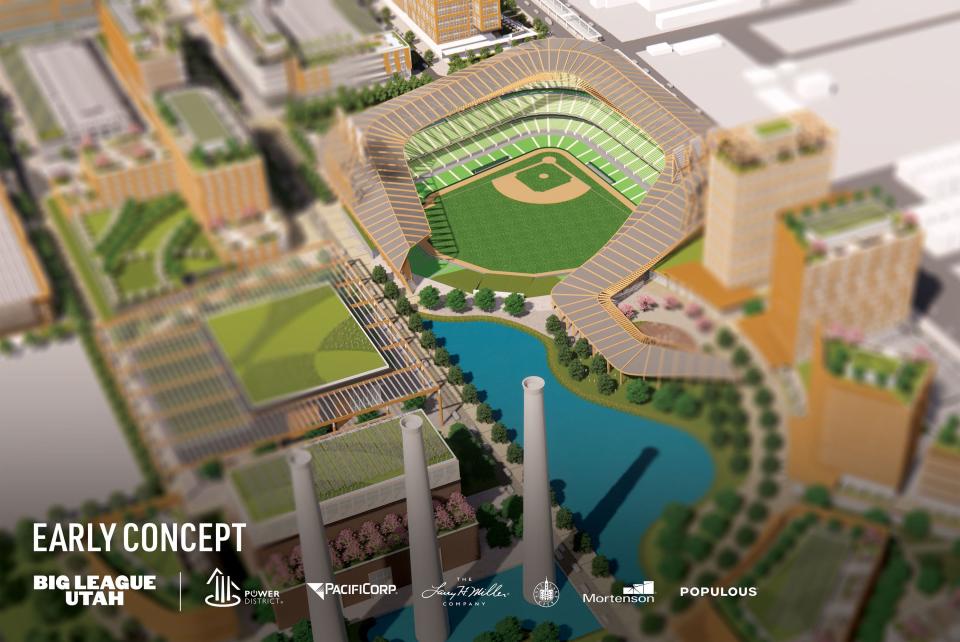Could a Major League Baseball team be a catalyst for Salt Lake City’s west side?

- Oops!Something went wrong.Please try again later.
Backers of an effort to bring a Major League Baseball team to Utah see a possible mixed-use sports and entertainment development in the Power District as a way to revitalize Salt Lake City’s west side.
Big League Utah, a broad-based coalition of prominent Utahns pushing the effort, intends to create a team foundation to benefit west-side community priorities if the city lands an expansion franchise.
The group announced those plans Wednesday along with the creation of honorary and community advisory boards whose members include the governor, state and local Republican and Democratic politicians and business leaders.
The proposed baseball stadium would sit between the Salt Lake International Airport and downtown and is bordered by I-80 and a light rail, as well as the Utah State Fairpark and Jordan River. The ballpark would offer views of the downtown skyline and the Wasatch Mountains.
Construction of a major league ballpark and entertainment district would almost certainly include some public investment for what could be a billion-dollar project. Utah government leaders are averse to diverting taxpayer dollars directly but have acknowledged tax increment financing or a public-private partnership could be options.
Related
The area west of downtown Salt Lake City has struggled to remain viable amid growing gentrification. Some residents in the area say new apartment developments are ruining the community and displacing families of color and family-owned businesses, while others see the residential projects as tackling the city’s housing shortage.
“I think the area right now is full of potential but lacking strategy. When you have potential but no strategy it leads to the kind of speculative development which is kind of what you see,” said Salt Lake City Councilmember Victoria Petro, who serves on the Big League Utah advisory board.
“It’s kind of this weird hybrid of like we could do so many good things but nothing is quite what we need it to be for it to be the thriving, robust boulevard entrance to the city that it should be.”
Petro, a New York Yankees fan and self-described Rose Park baseball mom, said a major league stadium in the Power District would be “catalytic.”
“We don’t need much to change,” she said. “What we do need is for there to be momentum and people who are capable of bringing investment and catalytic visionaries to stand alongside us and to grow what’s there.”
Related
Utah Senate Minority Leader Luz Escamilla agrees, calling the area an “opportunity zone.”
“It’s eager for more,” said the Salt Lake City Democrat, whose district includes the west side. “The reality is that area has been missing. It needs something to spark, to get it on fire.”
Escamilla, a member of the Big League Utah advisory board, said a major league ballpark could be that spark but the project must include business, housing and recreation. She said she’s excited for the prospect of baseball, though she expects some difficult conversations and wants to ensure west-side voices are heard.
“It has to have a very intentional commitment to those communities that will be impacted,” she said, noting the “beauty” of the area’s diversity. “That’s been very refreshing to see right now — the Millers, the family and their corporation engaging in those conversations with communities.”
The word catalyst comes up a lot among supporters of landing a baseball team who see it as an opportunity to lift and connect the city’s west side.
“Our advisory board is shining light on it, saying, ‘Let’s go invest there. Let's do this as a community together,’” said Steve Starks, CEO of the Larry H. Miller Company, which would head a potential baseball ownership group.
“That’s a remarkable thing to have such unity on, not only bringing baseball but also identifying a site that’s shovel-ready,” he said. “It’s really our community saying let’s invest in the Power District on the North Temple corridor and let’s use this as a catalyst for the west side.”
Related
The Miller family’s ties to the west side go way back.
“Larry and I graduated from West High School, and I have deep affection for our friends and neighbors in this community,” Gail Miller, co-founder and owner of the Larry H. Miller Company, said in a statement. Larry Miller also played softball on a field across the street from the fairgrounds that is now a gravel lot.
“If we are successful in securing an expansion team, we will use this platform to support organizations and initiatives focused on the west side, its families and local businesses,” she said, adding the company’s mission is to enrich lives and create lasting impact.

Steve Miller, chair of the Miller Company, said his family, who owned the Utah Jazz and who still own the Triple A Salt Lake Bees, knows the impact that sports can have on communities. He said they’re particularly excited about the impact a big league team could have on the west side.
“The Power District is perfectly located as a connector between people, businesses and sports in our capital city,” he said in a statement. “The potential and responsibility to be a catalyst in this community belongs to all of us.”
Derek Miller, president and CEO of the Salt Lake Chamber, said the business community is poised to support a big league franchise.
“Our data points to corporate enthusiasm for partnerships and season ticket purchases. A stadium, coupled with deliberate and visionary mixed-use development, will serve as an economic engine for our west side community,” he said.
Natalie Gochnour, an economist and executive director of the Kem C. Gardner Policy Institute, said Utah is a “mid-sized, high-amenity state.” Investment in pro sports enhances livability and makes cities more attractive to companies and talented workers, she said.
“I don’t think of economic impact as the tickets sold or the restaurants and the bars. That’s really interesting and it certainly enlivens a neighborhood but what I think is most helpful is to have high concentrations of educated workers in this urban environment. These workers, these companies can go anywhere, and they’ll choose places with life quality,” Gochnour said.
Also, she said stadiums and arenas are no longer stand-alone facilities like the Delta Center or America First Field but an entire district, “and that’s the plan here.
“You’re building a neighborhood, not a ballpark,” Gochnour said.
Related
Salt Lake City Mayor Erin Mendenhall said the city is on board to be the home of an MLB team. The city has a robust history of supporting professional athletics and looks forward to strengthening the anchor of sports in the capital city.
“With this proposal, you could walk out the front doors of the airport, class at the University of Utah, or dinner on Main Street, hop on a TRAX train and be to the front doors of a future stadium within minutes,” she said in a statement.
According to Big League Utah, board members’ expertise and commitment to Utah’s success will help advance its multifaceted campaign and focused efforts to land a team.
The honorary advisory board is comprised of Gail Miller, Gov. Spencer Cox; Senate President Stuart Adams; House Speaker Mike Schultz; Escamilla; Mendenhall; Petro; former Congressman Rob Bishop; and Point of the Mountain State Land Authority Board co-chair and former state representative Lowry Snow.
The community advisory board includes Steve Miller; Greg Miller, vice chair of the Larry H. Miller Company; Starks; Scott Anderson, president and CEO of Zions Bank; Dave Checketts, businessman and sports executive; Spencer P. Eccles, co-founder and managing partner of The Cynosure Group; Maria Garciaz, CEO of NeighborWorks Salt Lake; Kem Gardner, CEO of Gardner Companies; Gochnour; Gary Hoogeveen, president and CEO of Rocky Mountain Power; David Huntsman, president and COO of Huntsman Foundation; Derek Miller, president and CEO of the Salt Lake Chamber; Todd Pedersen, businessman and founder of Vivint Smart Home; Thayne Shaffer, president and CEO of America First Credit Union; Sidni Shorter, president and CEO of Utah Black Chamber; and Spencer Zwick, co-founder and managing partner of Solamere Capital.


